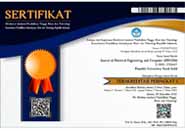Westerman, G., Bonnet, D., & Ferraris, P. (2014). The Digital Advantage: How Digital Leaders Outperform Their Peers in Every Industry. MIT Sloan Management Review.
Li, J., & lainnya. (2019). Block-sync: A lightweight consensus algorithm for blockchain database integration. Future Generation Computer Systems, 100, 531–540.
Zhang, S., Zheng, X., & Chen, J. (2018). ChainSQL: A blockchain database application platform. IEEE Access, 6, 14191–14204.
Zyskind, G., Nathan, O., & Pentland, A. (2015). Enigma: A blockchain-based approach to data accountability and provenance tracking. In Proceedings of the 2015 IEEE Conference on Security and Privacy in Communication Networks (SecureComm) (pp. 1–6).
Fan, K., Jiang, W., Li, H., Yang, Y., & Shen, J. (2020). Secure and scalable data sharing of electronic health records using permissioned blockchain and off-chain storage. IEEE Transactions on Industrial Informatics, 16(3), 2031–2039.
Lu, Y. (2019). Design of a secure supply chain system based on blockchain and RFID technology. IEEE Access, 7, 36612–36622.
Casino, F., Dasaklis, T. K., & Patsakis, C. (2020). A survey on blockchain-based systems and their integration with cloud computing and database systems. ACM Computing Surveys, 53(4), 1–34.
Liang, X., Zhao, J., Shetty, S., Liu, J., & Li, D. (2018). Blockchain-oriented dynamic data management framework for health data analytics. IEEE Transactions on Network Science and Engineering, 7(3), 2211–2222.
Yaqoob, I., Salah, K., Jayaraman, R., & Al-Hammadi, Y. (2021). Blockchain for data integrity in Internet of Things applications: A review. IEEE Communications Surveys & Tutorials, 23(1), 524–552.
Kuo, T. T., & Ohno-Machado, L. (2019). Towards hybrid blockchain database systems: Design and implementation challenges. Blockchain in Healthcare Today, 2, 1–9.
Shen, M., Deng, Y., Zhu, L., Du, X., & Guizani, M. (2019). A data storage model based on blockchain and cloud storage. IEEE Access, 7, 70816–70826.
Gartner. (2022). Market Guide for Digital Transformation in Government. Gartner Research.
Narayanan, A., Bonneau, J., Felten, E., et al. (2016). Bitcoin and Cryptocurrency Technologies. Princeton University Press.
Eubanks, V. (2018). Automating Inequality: How High-Tech Tools Profile, Police, and Punish the Poor. St. Martin’s Press.
Yulianto, B., Kartika, A., & Rahmawati, F. (2020). Sistem Informasi Kepegawaian Terintegrasi untuk Pemerintah Daerah. Jurnal Sistem Informasi dan Teknologi, 9(1), 22–30.
Cachin, C. (2016). Architecture of the Hyperledger Blockchain Fabric. [Hyperledger White Paper].
Undang-Undang Republik Indonesia Nomor 5 Tahun 2014 tentang Aparatur Sipil Negara.
Peraturan Bupati Madiun Nomor 5 Tahun 2019 tentang Sistem Informasi Manajemen Kepegawaian di Lingkup Pemerintah Kabupaten Madiun.
Badan Pusat Statistik. (2023). Kabupaten Madiun dalam Angka 2023. BPS Kabupaten Madiun.
Nakamoto, S. (2008). Bitcoin: A Peer-to-Peer Electronic Cash System. [Online]. Tersedia di: https://bitcoin.org/bitcoin.pdf
Tapscott, D., & Tapscott, A. (2016). Blockchain Revolution: How the Technology Behind Bitcoin is Changing Money, Business, and the World. Penguin.
Andryo, H., & Pratama, R. (2021). Implementasi Blockchain dalam Pengelolaan Sertifikat Digital. Jurnal Teknologi Informasi dan Ilmu Komputer, 8(2), 145–152.
Kurniawan, D., & Suryanegara, M. (2020). Blockchain untuk Sistem Pemerintahan Terbuka. Jurnal Sistem Informasi, 16(1), 43–52.
Arifin, Z., & Ramdhani, M. A. (2021). Studi Implementasi Blockchain pada Sistem Informasi Kepegawaian. Jurnal Ilmiah Teknologi Informasi Asia, 15(2), 85–92.
Putra, Y. H., & Wibowo, A. (2022). Desain Arsitektur Blockchain untuk Aplikasi Pelayanan Publik. Jurnal Teknologi dan Sistem Komputer, 10(3), 287–293.
Dewi, I. K., & Suryanto, A. (2020). Evaluasi Sistem HRIS dengan Blockchain. Jurnal Rekayasa dan Manajemen Sistem Informasi, 6(4), 311–319.
Gunawan, A., & Rakhmadi, A. (2022). Aplikasi Blockchain dalam Dunia Pemerintahan. Jurnal Administrasi Publik, 13(1), 91–100.
Wahyuni, L., & Hidayat, R. (2021). Pemanfaatan Blockchain untuk Meningkatkan Transparansi Data ASN. Jurnal Manajemen dan Teknologi Informasi, 9(1), 37–46.
Nasution, F., & Santoso, D. (2020). Blockchain untuk E-Government: Peluang dan Tantangan. Jurnal Sistem Informasi Bisnis, 10(2), 165–172.
Permana, D., & Zulkarnain, A. (2022). Analisis Blockchain pada Aplikasi Mutasi Pegawai. Jurnal Teknologi dan Informasi, 11(2), 204–212.
Irawan, D., & Syahputra, M. (2021). Blockchain untuk Sistem Verifikasi Ijazah. Jurnal Pendidikan dan Teknologi, 2(1), 74–81.
Siregar, B., & Hadi, F. (2020). Studi Komparatif Blockchain Ethereum dan Hyperledger. Jurnal Teknologi Informasi, 14(3), 221–229.
Yusuf, A., & Dwi, R. (2021). Pengembangan Sistem Kepegawaian Berbasis Hyperledger. Jurnal Sistem Informasi dan Teknologi, 8(1), 15–22.
Nugroho, A., & Kusuma, D. (2020). Hyperledger Fabric: Solusi Blockchain Private untuk Pemerintah. Jurnal Informatika dan Komputer, 10(2), 109–116.
Hidayat, A., & Rosyadi, A. (2021). Pemanfaatan Blockchain dalam Proses Bisnis Pemerintah. Jurnal Riset Teknologi Informasi, 13(4), 357–366.
Satria, R., & Lestari, Y. (2020). Evaluasi Arsitektur Blockchain dalam Pengelolaan Data Publik. Jurnal Teknologi Informasi dan Komputer, 9(3), 217–223.
Lazuardi, A., & Ramadhan, H. (2021). Sistem Informasi Kepegawaian Terintegrasi Berbasis Blockchain. Jurnal Teknologi dan Manajemen Informatika, 7(2), 130–138.
Setyawan, F., & Kurniawati, D. (2020). Keamanan Data ASN dengan Blockchain. Jurnal Sistem Informasi dan Keamanan Siber, 3(1), 67–74.
Hanafiah, M. A., & Suryana, A. (2022). Blockchain dalam Transformasi Digital Pemerintah Daerah. Jurnal Informasi dan Administrasi, 5(1), 99–106.
Mulyadi, H., & Fitriani, N. (2021). Studi Penerapan Blockchain di Instansi Pemerintah. Jurnal Sistem Cerdas, 2(3), 205–212.
Kementerian PAN-RB. (2020). Pedoman Sistem Pemerintahan Berbasis Elektronik (SPBE). Jakarta: KemenPAN-RB.
World Bank. (2020). Enhancing Government Effectiveness and Transparency: The Fight Against Corruption. Washington, DC: World Bank Group.
ISO/IEC. (2018). ISO/IEC 30141: Internet of Things (IoT) – Reference Architecture. International Organization for Standardization.
Kemenkominfo. (2022). Strategi Nasional Keamanan Siber 2022–2024. Jakarta: Kementerian Komunikasi dan Informatika RI.
 (Universitas AMIKOM Yogyakarta)
(Universitas AMIKOM Yogyakarta) 








